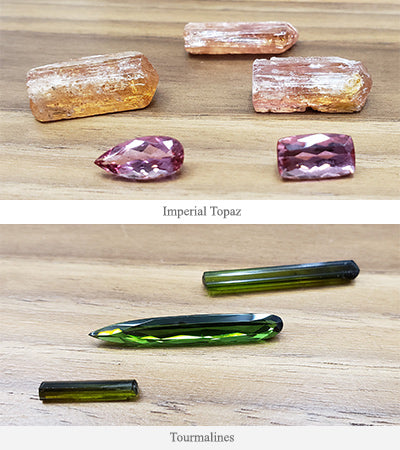January 2020 - Cutting

From classical to fantasy shapes, there are many different styles when it comes to cutting a stone. However, there are several factors to consider before doing so, such as the yield of the final stone compared to the rough, the inclusions, the colour, the shape of the rough stone, etc.
|
Cutting factories often have their specialization. While some only cut small stones such as melees or precision cuts, others are dedicated to production and custom size, etc. That's why we work with various cutters that can meet your diverse needs. |


|
|||
|

|
Stones such as quartz (amethyst, citrine, smoky quartz, etc.), some garnets and topazes, can be cut in all possible shapes or sizes without any problem. As these stones are more common, it is easy to find a rough that will fit the desired shape. And since they are relatively inexpensive, the yield relative to the rough is not as important. |


Colour
| Many stones such as sapphire and ruby, tourmalines, tanzanite and beryl will cause an optical phenomenon called pleochroism; that is, light is not absorbed in the same way from all angles. An angle can reveal a distinct shade of the colour (tourmalines) or a completely different colour (tanzanite and andalousite). This is an important factor to consider in order to get the best possible colour when cutting a stone. |

 Another factor to consider with colour is the presence of colour zoning. The best colour zoning example is found in watermelon tourmaline, which has very contrasting colours. In some cases, such as quartz (amethyst and citrine) or sapphires, colour zoning can be more subtle. The stone can be cut either to reveal the different colours or to highlight a single colour.
Another factor to consider with colour is the presence of colour zoning. The best colour zoning example is found in watermelon tourmaline, which has very contrasting colours. In some cases, such as quartz (amethyst and citrine) or sapphires, colour zoning can be more subtle. The stone can be cut either to reveal the different colours or to highlight a single colour.
The shape of the rough
Gemstones are the result of a crystallization process and there are different crystalline systems, which results in different shapes of crystals.


Beryl (emeralds, aquamarine and morganite), imperial topaz and tourmaline are found in elongated crystals. Most of the time, they will be cut into various elongated shapes like pears, ovals or cushions.
|
Here are some examples of shapes and cuts: 
